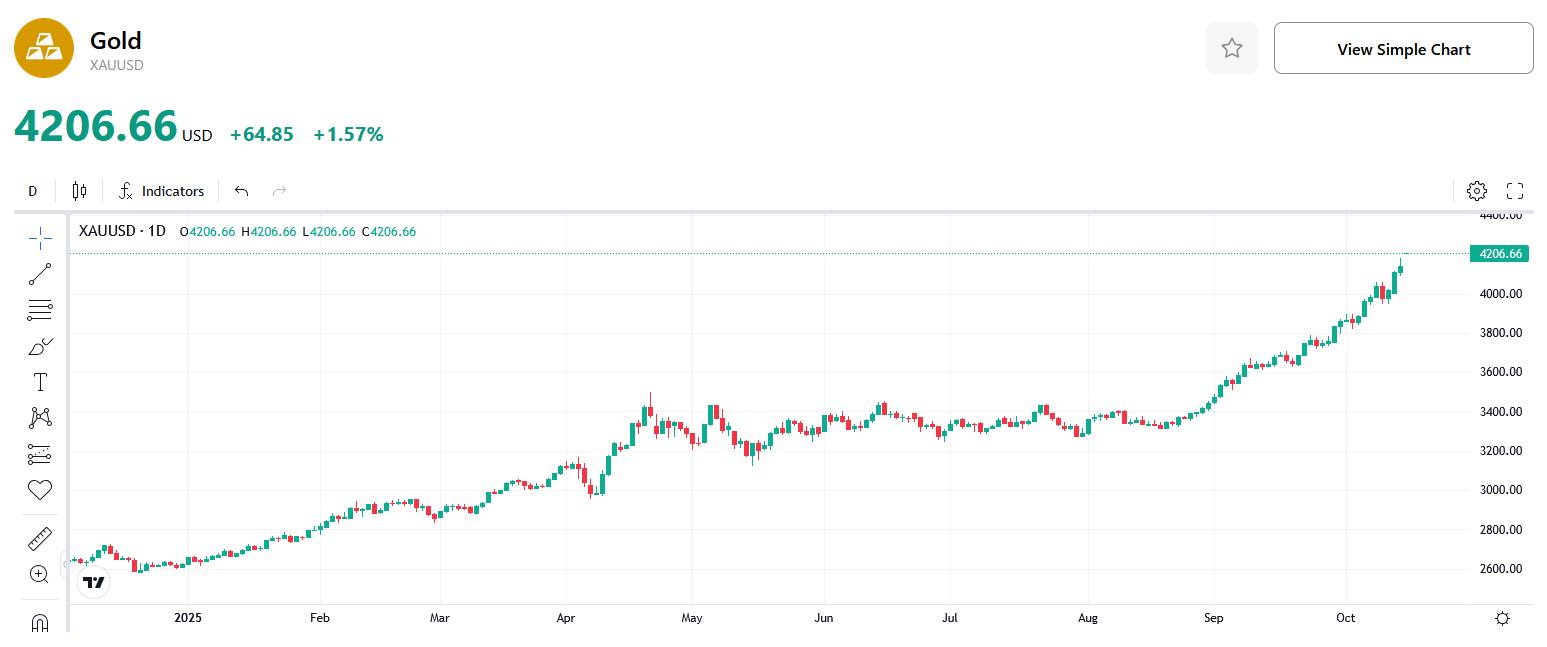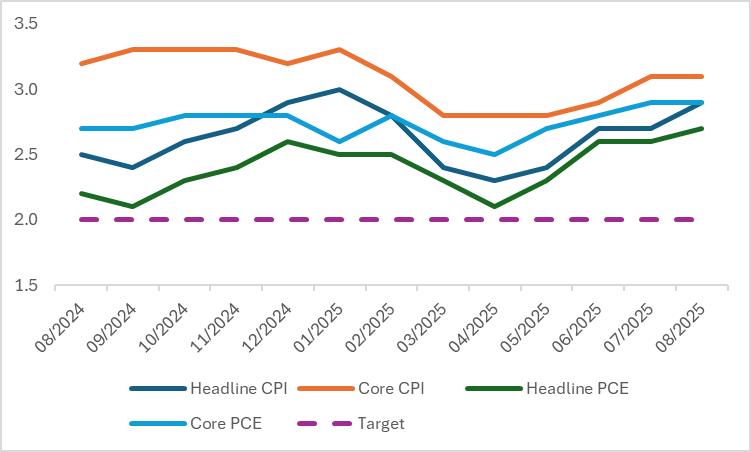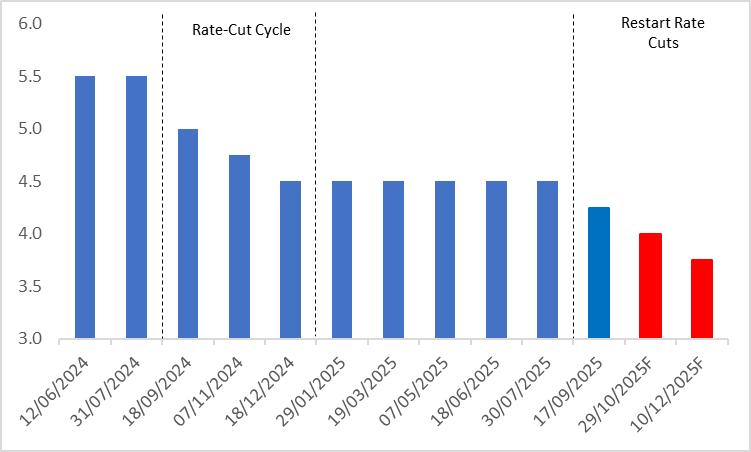Trump Meets Zelenskyy: Selling Tomahawk Missiles, Gold Investors Set to Profit Big?
1. Introduction
Amid sustained global central bank rate cuts, increased gold accumulation by emerging market central banks, persistent U.S. inflation, and a growing de-dollarisation trend, gold prices have surged significantly. Since the start of the year, international gold prices have risen by 57.6% (Figure 1), breaking through $4,200 per ounce to reach a new all-time high. The primary drivers of the latest round of rally include escalating U.S.-China trade tensions and dovish signals from Federal Reserve Chair Jerome Powell and other Fed officials.
Looking ahead, a pivotal event influencing gold prices will be the U.S.-Ukraine summit. On 17 October, President Trump is scheduled to meet with Ukrainian President Zelenskyy to discuss matters including the potential provision of U.S. "Tomahawk" cruise missiles to Ukraine. Should this plan materialise, it could escalate the Russia-Ukraine conflict, heightening global uncertainty and further driving gold prices upward.
Figure 1: Gold Prices ($/oz)

Source: TradingKey
2. Trump-Zelenskyy Summit
On Friday, 17 October, President Trump will meet with Ukrainian President Zelenskyy, marking Zelenskyy’s third White House visit since Trump’s return to office in January this year. Last weekend, the two leaders held a phone call focused on whether NATO allies would procure “Tomahawk” missiles for Kyiv—long-range weapons capable of extending Ukraine’s strike capabilities to Moscow and beyond.
The "Tomahawk" missile, manufactured by the United States, is a subsonic long-range cruise missile with a maximum range exceeding 2,000 kilometres. If launched from Ukraine, it could theoretically strike Moscow, the Russian capital. Analysts widely believe that if the U.S. supplies Ukraine with "Tomahawk" missiles, it would signal a dangerous escalation in U.S. involvement in the Ukraine conflict, further intensifying the Russia-Ukraine situation. Since October, Russian officials, including President Putin, have repeatedly warned that U.S. delivery of "Tomahawk" missiles to Ukraine would mark a significant escalation in the conflict, not only heightening tensions between Russia and Ukraine but also causing irreparable damage to U.S.-Russia relations.
3. Impact of "Tomahawk" Missile Sales on Gold Prices
If President Trump decides to supply Ukraine with Tomahawk missiles, the resulting escalation in geopolitical tensions would intensify the Russia-Ukraine conflict, amplifying gold’s safe-haven appeal. This would likely drive a surge in demand for gold, pushing prices higher. Historical data show that similar events, such as military aid initiatives or conflict escalations, have typically triggered significant gold price rallies. The primary reason is that investors, facing global uncertainty and potential supply chain disruptions, often shift capital to gold as a safe-haven asset. For instance, during the early stages of Russia’s invasion of Ukraine, gold prices rose from $1,903 per ounce on 24 February 2022 to a peak of $2,338 per ounce by April 2024, achieving a 22.8% increase over two years.
In the short term, the surge in gold prices would primarily stem from two factors. First, market panic would spread rapidly. Tomahawk missiles, as precision long-range strike weapons, are seen as a direct provocation to Russia, potentially prompting Moscow to respond aggressively, including through military retaliation or nuclear threats. This escalation in hostilities would significantly impact gold’s short-term trajectory. Data show that during the escalation of the Russia-Ukraine conflict in November 2024, gold prices rose from $2,561 per ounce to $2,718 per ounce in less than a month, a 6.1% increase. If Trump’s decision triggers similar concerns about nuclear escalation, gold prices could continue to reach new highs.
Second, the interconnected effects on commodity markets warrant close attention. The provision of missile aid and heightened geopolitical risks could drive significant increases in oil and natural gas prices, reinforcing inflation expectations and, in turn, supporting gold prices. Studies indicate that a 10% rise in the geopolitical risk index typically leads to an average 3% increase in gold prices in the short term. However, the extent of this short-term gold price surge will depend on the duration and scope of the event. If Trump’s stance is merely rhetorical without actual missile deployment, the gold price increase may be limited. Conversely, if the event triggers broader international responses, such as European allies providing additional support to Ukraine, gold prices could experience a substantial short-term spike.
4. Other Factors Influencing Gold Prices
Looking ahead, beyond geopolitical risks such as the Russia-Ukraine conflict, gold price increases will continue to be driven by a combination of global economic conditions, monetary policies, supply-demand dynamics, and broader macroeconomic trends. First, inflationary pressure remains a core driver. Currently, the U.S. Consumer Price Index (CPI) and Personal Consumption Expenditures (PCE) price index consistently exceed the 2% target, with inflation showing a notable upward trend since April 2025 (Figure 4.1). Amid ongoing uncertainties in the global trade environment, such as escalating U.S.-China trade tensions, U.S. inflation is unlikely to decline significantly in the short term. In a high-inflation environment, gold’s role as an inflation hedge will become more prominent, providing strong support for its price.
Second, alongside persistent U.S. inflation, the labour market is showing signs of weakness. Slowing private sector hiring, combined with government shutdowns and staff reductions, is likely to lead to weaker non-farm payroll data and rising unemployment rates in the coming months. Based on recent statements from Federal Reserve Chair Jerome Powell and other Fed officials, the Fed’s monetary policy focus is expected to remain on the labour market. It is anticipated that the Fed will implement two additional rate cuts of 25 basis points each before the end of the year (Figure 4.2). Globally, apart from the Bank of Japan, major central banks are in a rate-cutting cycle. Sustained rate cuts reduce the opportunity cost of holding gold, further driving its price upward.
Third, demand for gold reserves by central banks will continue to support prices. The ongoing de-dollarisation trend has driven emerging market countries to increase their gold holdings, with global central banks netting purchases of 1,500 tons of gold since the start of 2024. Looking ahead, as the global monetary system becomes more diversified, this trend of gold accumulation is expected to persist, providing a solid foundation for gold prices. These three driving forces—combined with rising demand for gold ETFs, concerns over the U.S. fiscal deficit, and the impact of global de-dollarisation—will collectively sustain upward pressure on gold prices.
Figure 4.1: U.S. CPI and PCE (%, y-o-y)

Source: Refinitiv, TradingKey
Figure 4.2: Fed Policy Rate (%)

Source: Refinitiv, TradingKey
5. Conclusion
All in all, the upcoming Trump-Zelenskyy summit is a critical event for gold prices. If President Trump agrees to supply Ukraine with "Tomahawk" missiles, the Russia-Ukraine conflict is likely to escalate further, and heightened geopolitical uncertainty will continue to drive gold prices higher. Even if the U.S. ultimately does not provide Ukraine with "Tomahawk" missiles, gold prices are expected to remain bullish due to persistent high inflation, accommodative monetary policies, increased gold purchases by global central banks, and the ongoing de-dollarisation trend. The difference would likely be a more moderate price increase in the absence of missile sales.



